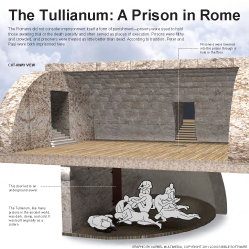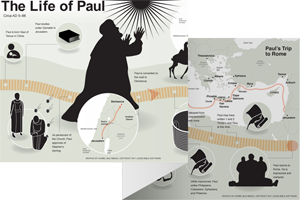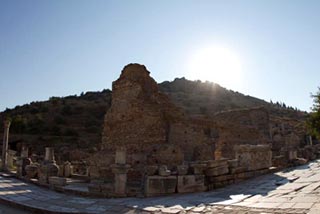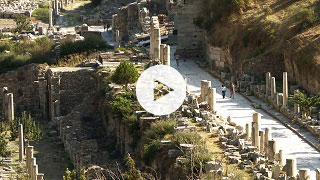1:1–2 Sometime after his captivity in Rome (ca. ad 61–63), Paul would have written the Pastoral Letters—1 Timothy, 2 Timothy, and Titus. This would have occurred toward the end of his life sometime in the mid-60s ad. |
1:1 Paul A missionary to the Gentiles and the writer of 13 nt letters. Paul’s ministry is the focus of Acts 13–28. See note on Rom 1:1.
is the focus of Acts 13–28. See note on Rom 1:1.
 Paul: A Life of Redemption and Transformation
Paul: A Life of Redemption and Transformation
apostle One commissioned for a particular task and given the authority to carry out the task. Having appointed Timothy as leader of the churches in Ephesus, Paul refers to himself as an apostle to remind those under Timothy’s leadership of his authority. See note on Rom 1:1.
Paul refers to himself as an apostle to remind those under Timothy’s leadership of his authority. See note on Rom 1:1.
 Pauline Self-Designations Table
Pauline Self-Designations Table
the command Jesus commissioned Paul as an apostle (Acts 9:3–6). Paul often appeals to His appointment from God to demonstrate his apostolic credentials (e.g., Rom 1:1; 1 Cor 1:1; Gal 1:15–16). Therefore, God is the source of Paul’s authority. If those under Timothy’s leadership reject this instruction, they ultimately reject God—not just Timothy.
God our Savior In the ot, the Israelites referred to God as “Savior” (Deut 32:15; Psa 27:9; Hab 3:18)—a title that emphasizes God as the source of salvation.
hope Describes a confident expectation of God’s promises, not a wishful expectation. Paul refers to Christ Jesus as the believers’ hope because His resurrection means believers also share in His life (see 1 Cor 15:13–19).
because His resurrection means believers also share in His life (see 1 Cor 15:13–19).
1:2 Timothy A traveling companion and coworker of Paul who aided in the spread of the gospel to the Gentiles.
A half-Gentile, half-Jewish disciple Paul met in Lystra (Acts 16:1; see note on Phil 1:1). Timothy’s mother, Eunice, was Jewish (2 Tim 1:5), but his father was Greek (Acts 16:1–3). Timothy joined Paul on his second missionary journey and traveled with him in Asia Minor (modern-day Turkey). Paul appointed Timothy |
true child This description likely reflects Paul’s high regard for Timothy as a trustworthy disciple (1 Cor 4:17; Phil 2:22; Titus 1:4). The reference may also reflect Paul’s discipleship of Timothy; Paul considered himself to be a spiritual father to those he brought to faith or nurtured in Christ (1 Cor 4:15; Gal 4:19).
Grace, mercy, and peace This greeting captures the essence of the gospel message—God’s grace through the sacrifice of Jesus Christ brings peace with God. Here Paul adds “mercy” to his typical greeting (compare Rom 1:7; Gal 1:3; Col 1:2).
1:3–11 After the greeting, Paul immediately addresses the problem that Timothy is facing at Ephesus—false teachers who are spreading errant teaching and conducting themselves in a manner unworthy of the gospel. Paul stresses the importance of upholding the sound teaching of the gospel and instructs Timothy to ensure that others are not teaching things contrary to God’s plan. The subject of combatting false teaching is prominent in the beginning and end of 1 Timothy (1 Tim 6:3–10). The nature of the false teaching is unclear, but Paul’s references to myths, genealogies, and teachers of the law may indicate that Timothy is facing a movement interested in spiritual speculation, mystical knowledge, and the Mosaic law. |
1:3 Macedonia A Roman province on the Balkan Peninsula; its territory roughly corresponds with the northern portion of modern Greece. Thessalonica and Philippi were located in Macedonia. The event that Paul mentions in this verse is not recorded in Acts.
The event that Paul mentions in this verse is not recorded in Acts.
Ephesus A harbor city located in Asia Minor (modern Turkey). Ephesus was one of the largest cities in the Roman Empire. Paul went to Ephesus on his second missionary journey (Acts 19:1) and spent three years there. In a farewell speech, he warned the Ephesian elders about the threat of false teachers (Acts 20:29–31). For this reason, Paul urges Timothy and the believers to hold on to sound doctrine (1 Tim 1:10; 6:3; 2 Tim 1:13).
was one of the largest cities in the Roman Empire. Paul went to Ephesus on his second missionary journey (Acts 19:1) and spent three years there. In a farewell speech, he warned the Ephesian elders about the threat of false teachers (Acts 20:29–31). For this reason, Paul urges Timothy and the believers to hold on to sound doctrine (1 Tim 1:10; 6:3; 2 Tim 1:13).
other doctrine Refers to teaching that does not align with the understanding of the gospel that Paul and other apostles proclaimed. Paul’s command assumes that Timothy is in a position to instruct these people, so it is likely that the false teaching arose within the church, possibly even among the elders. If that is the case, Timothy is being charged to correct their misunderstandings and misrepresentations of the gospel (compare 2 Thess 2:15; 2 Pet 3:15–16).
1:4 myths The Greek term used here, mythos, refers to legendary stories about the gods. It also could be used to describe stories generally understood to be false. Such tales distracted believers from the truth (i.e., the gospel message) and sound doctrine, resulting in ungodly behavior. Paul and Peter disapproved of myths (2 Tim 4:4; 2 Pet 1:16), even those of Jewish origin or influence (Titus 1:14). They used “myths” as a label for teachings considered especially immoral or dangerous.
genealogies A list of descendants (e.g., Gen 10; 1 Chr 1–9; Matt 1:1–17). Genealogies were used to legitimize the inclusion of an individual into a group or the succession of an individual into a role. Some believers in Ephesus may have used genealogies to exclude others from fellowship or ministry. Paul argues that no one should be excluded; rather, prayer should be made for all because God wants all people to be saved (1 Tim 2:1, 4). Believers must not make genealogies the subject of pointless speculation.
were used to legitimize the inclusion of an individual into a group or the succession of an individual into a role. Some believers in Ephesus may have used genealogies to exclude others from fellowship or ministry. Paul argues that no one should be excluded; rather, prayer should be made for all because God wants all people to be saved (1 Tim 2:1, 4). Believers must not make genealogies the subject of pointless speculation.
plan The Greek term used here, oikonomia, can be used to refer to God’s administration or management of the cosmos or specifically to God’s plan of salvation (e.g., Eph 1:10; 3:9). Paul also uses oikonomia to refer to his mission to spread the gospel (e.g., 1 Cor 9:17; Eph 3:2; Col 1:25), so the phrase here could be contrasting proper gospel-oriented ministry with the doctrinal mismanagement of the false teachers.
1:5 love The goal of instruction. Love stands in contrast to envy and strife, which are the by-products of controversy and disputes about words (1 Tim 6:4).
conscience The virtue of conscience along with love and faith were cardinal virtues for Jews, Greeks, and Christians in the Graeco-Roman world. Here Paul seems to be using these virtues to emphasize to Timothy that his instruction and condemnation of false teaching is being done in good faith, motivated by a moral responsibility to correct error and restore the faith of those led astray. “Conscience” is a key term in the Pastoral Letters (vv. 5, 19; 3:9; 4:2; 2 Tim 1:3; Titus 1:15).
1:6 fruitless discussion The Greek word used here, mataiologia (“empty words”), refers to talk that does not benefit anyone. Here it probably connotes the pointless babble of the ignorant and uneducated (see 1 Tim 1:7).
1:7 teachers of the law Likely refers to teachers focused on interpretation of the Mosaic law. The other two nt references to the Greek term nomodidaskaloi associate the term with the Pharisees (Luke 5:17; Acts 5:34). These other references suggest that Paul’s use of the term here may serve to draw a contrast between Christian and Jewish teachings.
1:8 law is good Refers to the Mosaic law. Paul emphasizes that the legitimate use of the law is ethical, setting a standard for moral behavior. While the law is good when used to correct the lawless (compare 2 Tim 3:16; Rom 7:12, 16), it is not a means of salvation, or source of myths and endless genealogies, as some teachers of the law suggest (1 Tim 1:4). See Rom 7:13–25 and note.
1:9 lawless and rebellious Paul stresses that the purpose of the law was to set a standard, not for the righteous but for the lawless (in Greek, anomos). The law identifies what behaviors should be condemned as sin, outlined in the vice list in 1 Tim 1:9–10. The list echoes the interpersonal ethics of the Ten Commandments in Exod 20:12–17.
one who kills his father Not only is this not honoring to parents (Exod 20:12), but it is also a crime worthy of the death penalty (see Exod 21:15).
1:10 sound teaching Refers to instruction that is consistent with the gospel message and teaching of the apostles—a theme of the Pastoral Letters (1 Tim 6:3; 2 Tim 1:13; Titus 1:9). In contrast to foolish controversies, sound teaching stirs God’s people to good works. For this reason, teachers must make sound teaching their focus, knowing that some will oppose it (1 Tim 1:10; 2 Tim 4:3).
1:11 gospel The good news (in Greek, euangelion) about God’s victory over sin and death on behalf of a sinful humanity. See Rom 1:1 and note.
(in Greek, euangelion) about God’s victory over sin and death on behalf of a sinful humanity. See Rom 1:1 and note.
 Euangelion Word Study
Euangelion Word Study
1:12–17 After referring to the gospel God entrusted to him in 1 Tim 1:11, Paul expresses his gratitude for the grace and mercy of Christ that he has benefited from even though he had violently persecuted the Church before his conversion. Paul uses the extreme example of his own experience to prove that Christ’s plan to save sinners applies to all, even people like him who had sinned directly against Christ by persecuting his followers. |
1:12 considered me faithful Paul repeatedly defers to Christ for establishing him in ministry. Paul did not undertake this mission by his own volition and authority. Rather, Paul was entrusted with the gospel (v. 11) and appointed as an apostle (2:7).
1:13 blasphemer A person who speaks disrespectfully about God in order to damage His reputation.
persecutor Before his conversion, Paul sought to persecute followers of Christ by arresting and imprisoning them (Acts 9:1–2; 22:5).
followers of Christ by arresting and imprisoning them (Acts 9:1–2; 22:5).
a violent man Paul not only sought to arrest followers of Christ, he also approved the murder of Stephen (Acts 8:1). In contrast, those who watch over God’s people must not be violent (1 Tim 3:2–3).
(Acts 8:1). In contrast, those who watch over God’s people must not be violent (1 Tim 3:2–3).
1:14 faith and love Two of the three core Christian virtues: faith, love, and hope (see 1 Cor 13:13; 1 Thess 1:3). In Paul’s letters, the natural outcome of faith in Christ is love for God and others.
1:15 trustworthy and worthy of all acceptance Variations of this formulaic expression occur five times throughout the Pastoral Letters (1 Tim 1:15; 3:1; 4:9; 2 Tim 2:11; Titus 3:8). This phrase serves to introduce or conclude a quotation of established teaching and to emphasize the truth of what is being said.
1:16 I was shown mercy Paul recognized that his violent actions against the followers of Christ deserved punishment (1 Tim 1:12). God’s mercy motivated Paul to serve faithfully (2 Cor 4:1).
1:17 forever and ever Expresses the conviction that God is worthy of endless worship and adoration.
Amen Expresses agreement or endorsement of what is said about God (e.g., Psa 72:19; 89:52).
1:18–20 This section concludes Paul’s opening instruction to Timothy regarding his ministry and his obligation to combat false teachers. Paul gives two examples of people who have not heeded his teaching and have gone astray from the faith—Hymenaeus and Alexander. |
1:18 prophecies Pronouncements inspired by God. These prophecies provide Timothy with direction for ministry and motivation to serve faithfully (i.e., to fight the good fight; compare 1 Tim 6:12). In difficult circumstances, he must remember that the Spirit of God is ultimately behind his appointment to leadership in Ephesus (see v. 3).
provide Timothy with direction for ministry and motivation to serve faithfully (i.e., to fight the good fight; compare 1 Tim 6:12). In difficult circumstances, he must remember that the Spirit of God is ultimately behind his appointment to leadership in Ephesus (see v. 3).
1:20 Hymenaeus A believer who turned from the faith and opposed Paul. Hymenaeus damaged the faith of other believers by claiming the resurrection had already taken place (2 Tim 2:17–18).
Alexander A believer who also deviated from the faith. He may be the same Alexander who did Paul much harm (2 Tim 4:14–15).
whom I have handed over to Satan Paul most likely means that he expelled Hymenaeus and Alexander from the community of believers and placed them into the realm of God’s enemy, Satan (see 1 Cor 5:5). The purpose of such discipline is restoration, not condemnation.
(see 1 Cor 5:5). The purpose of such discipline is restoration, not condemnation.
to blaspheme Refers to speaking irreverently about God and His truth (compare 1 Tim 1:13). In this context, the blasphemy committed by Hymenaeus and Alexander involves their rejection of a godly conscience, which resulted in the erosion of their faith (v. 19). Paul was once a blasphemer, but he acted ignorantly in unbelief. These men, on the other hand, did not act in ignorance—despite having knowledge of the truth, they turned from it.

|
About Faithlife Study BibleFaithlife Study Bible (FSB) is your guide to the ancient world of the Old and New Testaments, with study notes and articles that draw from a wide range of academic research. FSB helps you learn how to think about interpretation methods and issues so that you can gain a deeper understanding of the text. |
| Copyright |
Copyright 2012 Logos Bible Software. |
| Support Info | fsb |
 Loading…
Loading…





 Timothy
Timothy 
